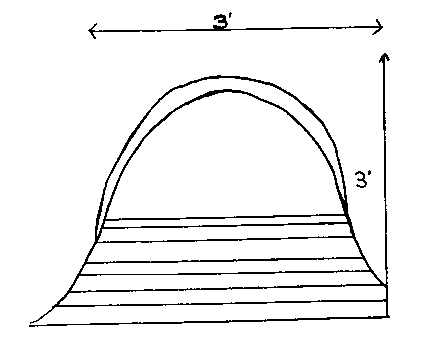

EAP Publications | Virtual Library | Magazine Rack | Search
Join the Ecological Solutions RoundtableEAP Publication - 56
Composting is a simple procedure, very similar to baking a cake. You have to have the right ingredients in the right proportion under the proper conditions, but there are only a few basic rules to follow, and after a little practice, you should have no major problems with your compost pile
The rapidity of the composting process depends on:
The material should be about as damp as a squeezed out sponge.
Size of the pile. Normally the pile should be 3 feet high, 3 feet wide, and as long as you like. If it is smaller, the material will eventually decompose, but it will not heat up sufficiently to kill weed seeds and pathogens.
Presence of microorganisms. A good way to make sure that there is an adequate supply of microorganisms in the pile is to add good garden soil, rotted manure or old compost.
The carbon/nitrogen ratio. Materials with high levels of carbon relative to nitrogen include paper, straw, sawdust, old leaves. Some food wastes, green plants, and grass clippings tend to be relatively high in nitrogen. The microorganisms in the soil that decompose organic matter need nitrogen for their bodies; when they are supplied with a high energy/ carbon source, they will use the nitrogen that is available in your garden soil. Therefore, it is not a good idea to add carbonaceous material to your garden unless you add some nitrogen with it, particularly during the growing season.
Similarly, when making the compost pile, it is important to provide enough nitrogen to the microorganisms to enable them to decompose the carbonaceous material. The carbon/nitrogen ratio in the material about to be composted should be roughly 30:1, and should have reached 10:1 in the finished product. It is difficult to estimate exactly how much green matter or carbonaceous material to add; this is a matter of experience.
How well the pile is insulated. It is important in cool regions to cover the pile or to compost in a container of some sort, especially during the fall and spring. The pile can be covered with a layer of soil, leaves, straw or plastic.
Frequency of turning. Usually the more frequently the pile is turned, the faster is the composting process. When making a fast, two week compost, the pile is turned every 3 days, but it can be turned much less frequently, depending on the amount of time you have to spend and how fast you want to compost. If the pile does not seem to be working, it is a good idea to turn and remake the pile, perhaps adding some green matter, or wetting it down if it seems too dry.
The more frequent the turning, and the faster the composting process the greater is the tendency to lose nitrogen, although other nutrients will tend to be conserved.
Nettles, comfrey or horsetail added to the compost, or put in the blender with some water and poured onto the pile can significantly speed up the composting process.

Urine is sterile when it leaves the body, so is safe to use, and is a good source of nitrogen and potassium. It can be collected in a bucket and poured on the compost or garden after being diluted.
Insulating layer of soil, straw, boards or plastic. Important for retaining heat and cutting out smells.
A layer of spaced stones or sticks laid crossways on the ground will encourage aeration of the pile. Leave space between the stones for earthworms to pass from the soil into the pile. You may find it difficult to turn the last layer of the pile if the sticks are too small. Another way to provide aeration is to loosen up the soil before laying the pile.
The best location for a compost pile is a well drained site, sheltered from the wind and sun, where it is most convenient to take organic wastes.
The pile can be constructed either by alternating layers of high carbon material, high nitrogen material, soil, and fertilizer if desired.
Or the materials can be mixed together as you go along.
Make sure you wet each layer of carbonaceous material so that it is as damp as a squeezed out sponge.
Remember alkaline materials such as lime or wood ash, when mixed with undecomposed nitrogenous material will lead to loss of nitrogen.
Adding phosphorus will tend to conserve nitrogen in the pile.
Copyright © 1981 Ecological Agriculture Projects
Info Request | Services | Become EAP Member | Site Map
Give us your comments about the EAP site
Ecological Agriculture Projects, McGill University (Macdonald
Campus)
Ste-Anne-de-Bellevue, QC, H9X 3V9 Canada
Telephone:
(514)-398-7771
Fax:
(514)-398-7621
Email: eapinfo@macdonald.mcgill.ca
To report problems or otherwise comment on the structure of this site, send mail to the Webmaster